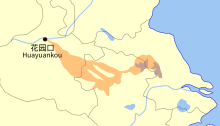
Back Наводнение по Хуанхъ Bulgarian Inundació del riu Groc de 1938 Catalan Povodeň na Žluté řece 1938 Czech Überflutung des Gelben Flusses 1938 German Inundo de Flava Rivero (1938) Esperanto Inundación del río Amarillo de 1938 Spanish طغیان رودخانه زرد (۱۹۳۸) Persian Keltaisenjoen tulva 1938 Finnish Inondation du fleuve Jaune de 1938 French השיטפון בנהר הצהוב (1938) HE

The 1938 Yellow River flood (simplified Chinese: 花园口决堤事件; traditional Chinese: 花園口決堤事件; pinyin: Huāyuánkǒu Juédī Shìjiàn; lit. 'Huayuankou Dam Burst Incident') was a man-made flood from June 1938 to January 1947 created by the intentional destruction of levees on the Yellow River in Huayuankou, Henan by the National Revolutionary Army (NRA) during the Second Sino-Japanese War. The first wave of floods hit Zhongmu County on 13 June 1938.
NRA commanders intended the flood to act as a scorched earth defensive line against the Imperial Japanese Armed Forces.[1][2][3] There were three long-term strategic intentions behind the decision to cause the flooding: firstly, the flood in Henan safeguarded the Guanzhong section of the Longhai railway, a major northwestern route used by the Soviet Union to send supplies to the NRA from August 1937 to March 1941.[4][5] Secondly, the flooding of significant portions of land and railway sections made it difficult for the Japanese military to enter Shaanxi, thereby preventing them from invading the Sichuan basin, where the Chinese wartime capital of Chongqing and China's southwestern home front were located.[6] Thirdly, the floods in Henan and Anhui destroyed much of the tracks and bridges of the Beijing–Wuhan railway, the Tianjin–Pukou railway and the Longhai railway, thereby preventing the Japanese from effectively moving their forces across Northern and Central China.[7] In the short term, the NRA aimed to use the flood to halt the rapid transit of Japanese units from Northern China to areas near Wuhan.[7][8][9][10]
The flood achieved the strategic intentions set by NRA commanders; in particular, the Japanese Operation 5 never captured Shaanxi, Sichuan or Chongqing. However, the flood came at enormous human cost, economic damages and environmental impact; in the immediate aftermath, 30,000 to 89,000 civilians drowned in the provinces of Henan, Anhui and Jiangsu,[11][12][13] while a total of 400,000 to 500,000 civilians died from drowning, famine and plague.[14][15] The Yellow River was diverted to a new course over swathes of farmland until the repair of the dykes in January 1947. Five million civilians lived on such inundated land until 1947.[15] Inspired by the strategic outcome, dykes elsewhere in China, especially along the Yangtze, were subsequently destroyed by Chinese and Japanese forces alike.[1]
- ^ a b Di Wu, "The cult of geography: Chinese riverine defence during the Battle of Wuhan, 1937-1938". War in History. Volume: 29 issue: 1, page(s): 185-204. https://doi.org/10.1177%2F0968344520961548
- ^ Dutch, Steven I. (November 2009). "The Largest Act of Environmental Warfare in History". Environmental & Engineering Geoscience. 15 (4): 287–297. Bibcode:2009EEGeo..15..287D. doi:10.2113/gseegeosci.15.4.287.
- ^ Muscolino, Micah S. (2014). The Ecology of War in China: Henan Province, the Yellow River, and Beyond, 1938–1950. Cambridge University Press.
- ^ 渠长根 (2003). 功罪千秋——花园口事件研究. East China Normal University (PhD). pp. 37, 38, 72.
- ^ 张龙杰 (2019). "全面抗战时期苏联对国共两党援助比较研究". 深圳社会科学 (4).
- ^ 渠长根 (2003). 功罪千秋——花园口事件研究. East China Normal University (PhD). pp. 38, 41, 73.
- ^ a b 渠长根 (2003). 功罪千秋——花园口事件研究. East China Normal University (PhD). pp. 23–24, 72–73.
- ^ Cite error: The named reference
NIDSwas invoked but never defined (see the help page). - ^ Cite error: The named reference
Fu and Hong 2015was invoked but never defined (see the help page). - ^ Eastman, Lloyd E. (1986). "Nationalist China during the Sino-Japanese War 1937-1945". In Twitchett, Denis; Fairbank, John (eds.). The Cambridge History of China, Volume 13: Republican China 1912-1949, part 2. Cambridge University Press. p. 555.
- ^ Cite error: The named reference
Kuo Tai-chun 2015awas invoked but never defined (see the help page). - ^ Cite error: The named reference
Kuo Tai-chun 2015bwas invoked but never defined (see the help page). - ^ Cite error: The named reference
Tang 1995was invoked but never defined (see the help page). - ^ Cite error: The named reference
Wang Zhibinwas invoked but never defined (see the help page). - ^ a b Cite error: The named reference
Bi Chunfu 1995was invoked but never defined (see the help page).
© MMXXIII Rich X Search. We shall prevail. All rights reserved. Rich X Search